Explore the following sections and recipes:
Savory Spices | How to Roast and Grind Spices | Yellow Split Pea Dal | Roasted Winter Squash With Garam Masala | Collard Greens With Tomatoes, Ginger, and Turmeric | Sautéed Fish With Sesame | Sautéed Brussels Sprouts With Coconut | Tandoori Chicken One-Pan Dinner | Fresh Coconut Chutney | Cilantro-Mint Chutney | DIY Garam Masala
Aromatic and deeply flavorful, Indian food is full of fresh ingredients, heady spices, and vibrant colors. It’s also loaded with powerful anti-inflammatory phytonutrients.
If Indian cooking is new to you, it might seem daunting, but don’t worry: You’ll find that these dishes come together with surprising ease.
Don’t let the bevy of spices intimidate you, either. Once you know how to handle them, you’ll find that creating these intoxicating flavor combinations is pretty straightforward.
In fact, with a few culinary successes under your belt, you just might decide to make Indian-influenced meals a bigger part of your regular kitchen repertoire.
The Essence: Savory Spices
A hallmark of Indian cooking, aromatic spices are best when they’re super fresh. You can save money by buying fresh spices in small quantities — look in the bulk aisle of your local natural-foods market.
To bring out even more of their flavor potential, check out our instructions for roasting and grinding them below.
1. Cardamom: Spicy-sweet and fragrant, cardamom has a warming quality. Long known for aiding digestion and fighting infection, it contains antioxidant and anti-inflammatory phytonutrients shown to protect against certain cancers and thought to help improve -circulation.
2. Coriander: These seeds taste nothing like the cilantro plant on which they grow: They are floral and fragrant, with a citrusy, sagelike flavor. Coriander seeds have anti-inflammatory and antibacterial properties, as well as cholesterol-improving effects. They also help regulate blood sugar.
3. Garam Masala: A blend of spices — usually coriander, cumin, black pepper, cloves, cardamom, bay leaves, and cinnamon — garam masala adds warmth and brightness to dishes. You can buy it ready-made, but it doesn’t take long to prepare your own using freshly ground spices (see the recipe below).
4. Cumin: Considered one of India’s favorite spices, cumin is a staple ingredient in curries — “curry” being a generic name for dishes that include a variety of spices, often served in a sauce. Helpful for regulating blood sugar and aiding digestion, freshly ground cumin seeds contain potent antioxidants.
5. Mustard Seeds: When ground or cracked, mustard seeds have a sharp scent, but when cooked in oil like popcorn, they’re sweet and nutty. The seeds’ phytonutrients have many protective effects, and they are also rich in selenium, which can help reduce the severity of asthma and symptoms of rheumatoid arthritis.
6. Turmeric: With its peppery, woody aroma, turmeric is a major component in most curries, adding an earthy flavor and bright yellow color. A powerful anti-inflammatory, it contains the phytonutrient curcumin, which has been shown to help prevent several cancers and protect the heart.
How to Roast and Grind Spices
If you find you really love cooking with Indian spices, consider roasting and grinding them yourself. Doing so dramatically enhances their flavors and is well worth the small extra effort.
Roasting: Dry-roasting your whole spices before you grind them makes them more aromatic and gives them a richer flavor; just let them cool before placing them in the grinder.
- Heat a small skillet over medium-high heat. Warm the spices in the skillet and shake the pan to toast the spices evenly. This should take one to two minutes; the spices will be highly fragrant.
- Remove spices from skillet to cool.
Grinding: Spices such as cumin and cardamom lend themselves to fresh grinding, and their flavors are considerably brighter than their pre-ground counterparts. Note that you’ll have to either shell the cardamom pods — not too cumbersome considering you usually need only a small amount — or buy whole, shelled cardamom seeds at an Indian market.
- Place whole spices in a spice grinder or coffee grinder and grind until the texture resembles that of finely ground back pepper. (If you use a coffee grinder, use a dedicated one: The oil in coffee doesn’t mix well with spices.)
- Alternatively, a low-tech mortar and pestle works beautifully for grinding. You can replicate this ancient tool using other normal kitchen tools: Place spices in a bowl and use the bottom of a small jar to grind them.
- Store ground spices in a tightly sealed container away from excessive light, heat, and humidity. They will keep well for up to two months.
Yellow Split Pea Dal
Dal is a soup or creamy side dish made from dried peas or beans that is often served alongside Indian meals. This soup version is subtle in flavor and comforting. Add more or less jalapeño to adjust spiciness.

Makes four to six servings | Hands-on preparation time 15 minutes | Total preparation time 90 minutes
- 1 cup yellow split peas, rinsed well
- 7 cups water
- 1 tsp. ground turmeric
- 1 cinnamon stick
- 3 tbs. ghee (or butter)
- 1 tbs. ground coriander
- 11/2 tsp. whole cumin seeds
- 1/4 tsp. ground cloves
- 1/2 tsp. ground cardamom
- 1/2 tsp. fresh ground black pepper
- 1 to 3 jalapeños, minced
- 4 medium, ripe tomatoes, chopped, about 3 cups (or canned)
- Salt to taste
- 4 tbs. coarsely chopped fresh cilantro
Directions
- Combine the split peas, water, turmeric, cinnamon stick, and 1 tablespoon of the ghee in a large saucepan over high heat. Bring to a boil.
- Cover, reduce heat to low, and simmer, stirring occasionally, for 45 minutes to an hour until the peas are tender. Remove the cinnamon stick and stir the dal to make it smooth and creamy.
- When the dal is finished cooking, heat a large skillet over medium heat, and dry-roast the coriander, cumin seeds, cloves, cardamom, and black pepper for one to two minutes, shaking the pan to toast the spices evenly until they are highly fragrant.
- Stir in the remaining 2 tablespoons of ghee to combine with the spices, then add the jalapeños and tomatoes and sauté over medium heat.
- Add a little salt, and simmer until the tomatoes are softened and the liquid has been reduced. Add the cooked vegetables and spices to the dal, and adjust the seasonings to taste.
- Top with cilantro to serve.
Roasted Winter Squash With Garam Masala
This is a satisfying side dish to serve with grilled meats or fish. The recipe also works wonderfully with other squashes or vegetables like carrots, cauliflower, green beans, or sweet potatoes.

Makes four to six servings | Hands-on preparation time 15 minutes | Total preparation time 35 minutes
- 2 tbs. ghee or coconut oil
- 6 cups cubed butternut squash
- 1 tbs. garam masala
- Salt to taste
Directions
- Preheat oven to 400 degrees F.
- Oil a baking sheet with the ghee or coconut oil and spread the squash cubes in a single layer on the sheet.
- Sprinkle with garam masala and salt; toss to coat.
- Roast the squash, stirring every 10 minutes until it is nicely caramelized, about 25 minutes.
Collard Greens With Tomatoes, Ginger, and Turmeric
The turmeric in this dish adds a beautiful color to the sauce. You can sub Swiss chard or kale for the collards, but reduce the cooking time slightly because they are more tender.

Makes four servings | Hands-on preparation time 15 minutes | Total preparation time 20 minutes
- 2 bunches collard greens, stems removed, leaves cut into 2-inch pieces (about 6 cups)
- 2 tbs. ghee or coconut oil
- 1 tsp. black mustard seeds
- 1 tbs. minced ginger
- 1 jalapeño, minced
- 1 tsp. ground turmeric
- 1 large tomato, diced
- 1/2 tsp. salt
Directions
- Soak the cut collard greens in water to wash; dry in a salad spinner to remove excess moisture.
- Heat the ghee or coconut oil in a large Dutch oven or sauté pan with a lid. Add the mustard seeds and allow them to pop in the covered pan.
- Add the minced ginger, jalapeño, and turmeric, and sauté for five minutes, until aromatic.
- Add the tomato and salt, and cook a few minutes longer to make a sauce.
- Add the collard greens and cover the pan for a minute or two to wilt the greens.
- Stir well to coat the greens, and then continue to simmer uncovered until the greens are tender, about five to seven minutes.
Sautéed Fish With Sesame
You can use any firm white fish for this recipe, including corvina, Alaska pollock, catfish, or haddock. For an easy side dish, take advantage of the fragrant golden oil remaining in the pan: Add a handful of dark leafy greens to the oil after you have removed the fish, and sauté briefly to wilt.
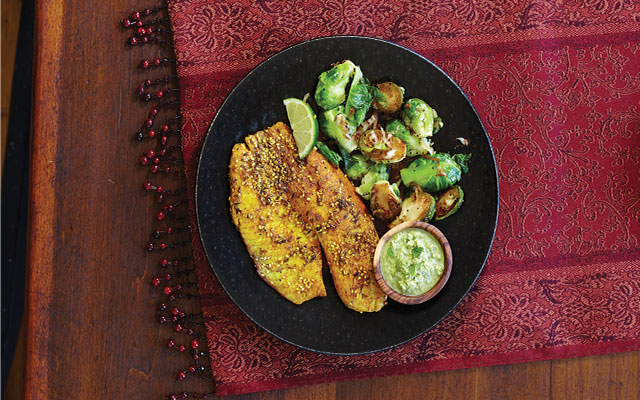
Makes four servings | Hands-on preparation time 10 minutes | Total preparation time 15 minutes
- 2 tbs. sesame seeds
- 1 tbs. whole cumin seeds
- 1 tsp. ground turmeric
- 1 tsp. ground coriander
- 1/2 tsp. paprika
- 1/4 tsp. cayenne pepper
- Fresh ground black pepper and salt to taste
- 4 4-oz. fish fillets
- 2 tbs. ghee, sesame oil, or coconut oil
- 1/4 cup chopped fresh cilantro
- 1 lime, quartered
Directions
- Mix the seasonings in a bowl. Press each fish fillet in the seasoning and turn to coat each side.
- Heat a large cast-iron skillet until a few drops of water flicked into the pan sizzle. Add the ghee or oil.
- Place the fish fillets in the pan and sear them about two to three minutes on each side. Check the fillets with a fork to see if they are cooked through.
- Serve fish sprinkled with chopped fresh cilantro and a lime quarter.
Sautéed Brussels Sprouts With Coconut
This dish is great alongside grilled meats or fish. Freshly grated coconut adds rich flavor, but if you don’t have fresh coconut, look for frozen grated coconut at Indian or health-food markets to use instead. If you have only dried coconut, soak it overnight in 1/4 cup coconut water.
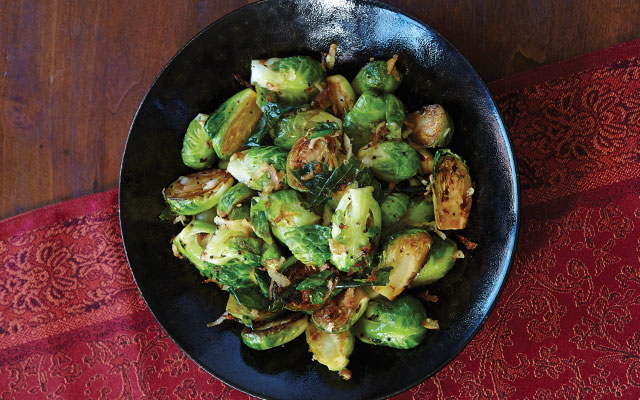
Makes four servings | Hands-on preparation time 15 minutes | Total preparation time 20 minutes
- 1 lb. Brussels sprouts, stem tips cut off and outer leaves removed
- 2 tbs. ghee (or butter)
- 1 tsp. black mustard seeds
- 5 fresh curry leaves or 2 dried bay leaves
- 1/2 cup coarsely grated fresh coconut
- 1 tsp. garam masala
- 1/8 tsp. nutmeg
- 1/4 tsp. cayenne pepper, or to taste
- Salt to taste
- 1 lime, quartered
Directions
- Heat 2 quarts of salted water and bring to a vigorous simmer. Add the Brussels sprouts and blanch for two minutes, then drain and cool by rinsing under cold water. Cut each sprout in half and set aside.
- Next, heat 1 tablespoon of ghee in a large skillet. When the ghee is hot but not smoking, add the black mustard seeds; cover the skillet with a lid when the seeds begin to pop. When nearly all the seeds are popped, remove the lid and add the curry or bay leaves and coconut. Stir, and allow to toast until golden, about one minute.
- Remove the coconut and seasonings from the pan with a spoon and set aside. Add the remaining 1 tablespoon of ghee and the halved sprouts to the pan and turn heat to medium-high. Sprinkle sprouts with the garam masala, nutmeg, and cayenne. Stir-fry until golden.
- Return the coconut and seasonings to the pan and mix well. Add salt according to taste.
- Serve with a lime quarter.
Tandoori Chicken One-Pan Dinner
Tandoori chicken is a classic at most Indian restaurants. We wanted a recipe that would provide the signature bright red color without food coloring — or a special tandoor oven. Marinate the chicken beforehand and then roast all the ingredients together on one pan. Serve with brown rice and your favorite chutneys. This recipe has been adapted from Raghavan Iyer’s book Indian Cooking Unfolded.

Makes four to six servings | Hands-on preparation time 20 minutes | Total preparation time 1 hour
- 6 boneless, skinless chicken thighs, about 1 1/2 lbs.
- 1/2 cup plain yogurt
- 1 tbs. ginger, minced
- 1 tbs. garlic, minced
- 2 tsp. garam masala, divided
- 3/4 tsp. sea salt
- 1 tsp. paprika
- 1/2 tsp. cayenne pepper
- 1 tbs. ghee
- 2 cups matchstick-cut carrots
- 3 cups cauliflower florets
- 1 cup yellow onion strips
- 1 red bell peppers, cut into strips
- 1 jalapeño pepper, sliced thin (optional)
- 1/2 cup chopped fresh cilantro
- Salt to taste
Directions
- Cut the chicken thighs into bite-sized pieces.
- Mix the yogurt, ginger, garlic, 1 teaspoon of the garam masala, sea salt, paprika, and cayenne pepper together until smooth. Toss the chicken-thigh pieces in the yogurt to coat, and allow to marinate in refrigerator for at least an hour or up to six hours.
- Preheat the oven to 400 degrees F and spread a large sheet tray with ghee.
- Toss the carrots, cauliflower, onion, and peppers with the remaining 1 teaspoon of garam masala and a little salt.
- Arrange the chicken pieces on one end of the pan and the vegetables on the other. Roast for 30 to 40 minutes, or until cooked through and well browned, stirring after 15 minutes of roasting time to mix chicken and vegetables.
- When the chicken and vegetables are well roasted, remove from oven, sprinkle with chopped cilantro, and serve.
Fresh Coconut Chutney
This creamy chutney adds brightness to any Indian recipe, and is especially tasty on a lamb curry.
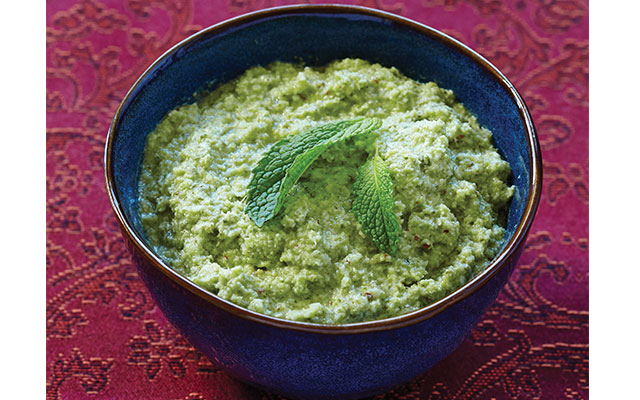
Makes about 3/4 cup | Total preparation time 15 minutes
- 1 jalapeño pepper, seeded and chopped
- 1/2-inch piece of peeled ginger
- 5 whole blanched almonds or cashews
- 2 tbs. water
- 1 tbs. fresh lime juice
- 3 tbs. fresh mint leaves, tightly packed
- 1/2 cup grated fresh coconut (or frozen)
Directions
- Blend all ingredients together in a blender until smooth, scraping down sides to blend thoroughly.
- Add a pinch of salt to season.
Cilantro-Mint Chutney
From the June 2012 issue, “Cooking With Spinach.”
Makes about 1 1/2 cups
- 1 small jalapeño, about 2 tbs., coarsely chopped
- 2 garlic cloves
- 1/2 yellow onion, about 1/2 cup, coarsely chopped
- 1-inch chunk fresh ginger, coarsely chopped
- 1 tomato, coarsely chopped
- 1 cup cilantro, coarsely chopped
- 1/4 cup mint leaves, coarsely chopped
- Salt to taste
Directions
- Blend all ingredients together in a blender until smooth.
- Store in the refrigerator until ready to serve.
Punjabi Garam Masala
Makes about 1/4 cup | Hands-on preparation time 15 minutes | Total preparation time 30 minutes
This recipe is from 660 Curries by Raghavan Iyer.
- 1 tbs. coriander seeds
- 1 tsp. cumin seeds
- 1 tsp. whole cloves
- 1/2 tsp. black peppercorns
- 1/2 tsp. cardamom seeds, removed from black pods
- 3 cinnamon sticks, each 3 inches long and broken into smaller pieces
- 3 fresh or dried bay leaves
Directions
- Preheat a small skillet over medium-high heat. Add all the spices and the bay leaves and toast, shaking the skillet every few seconds, until the coriander and cumin turn reddish brown; the cloves, peppercorns, and cardamom turn ash black; the cinnamon and bay leaves appear brittle and crinkly; and the mixture is highly fragrant, one to two minutes.
- Immediately transfer the nutty-smelling spices to a plate to cool. Once they are cool to the touch, place them in a spice grinder or coffee grinder, and grind until the texture resembles that of finely ground black pepper. The ground blend will be reddish brown and the aroma will be sweet and complex.
- Store in a tightly sealed container, away from excess light, heat, and humidity, for up to two months.
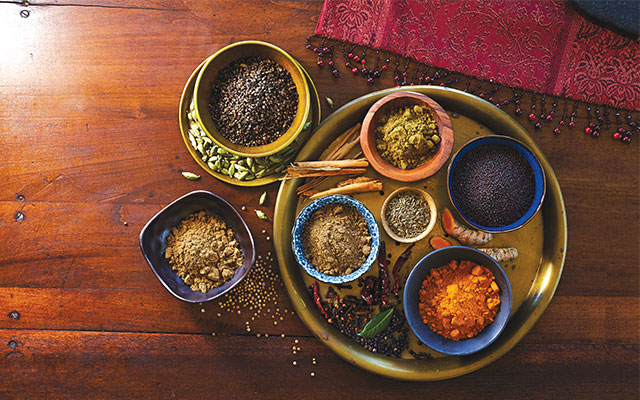

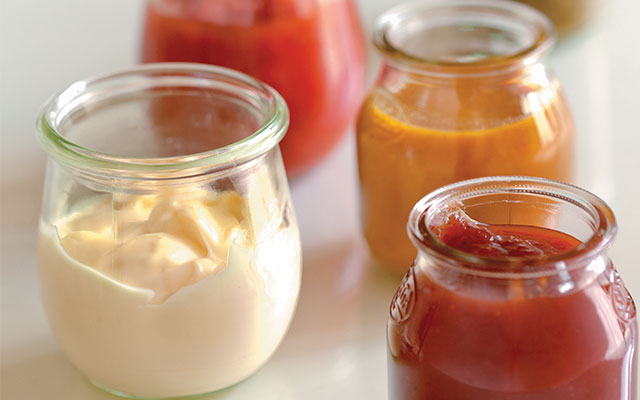

This Post Has 0 Comments